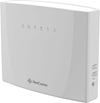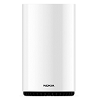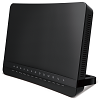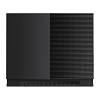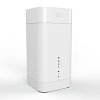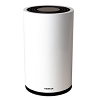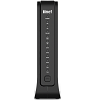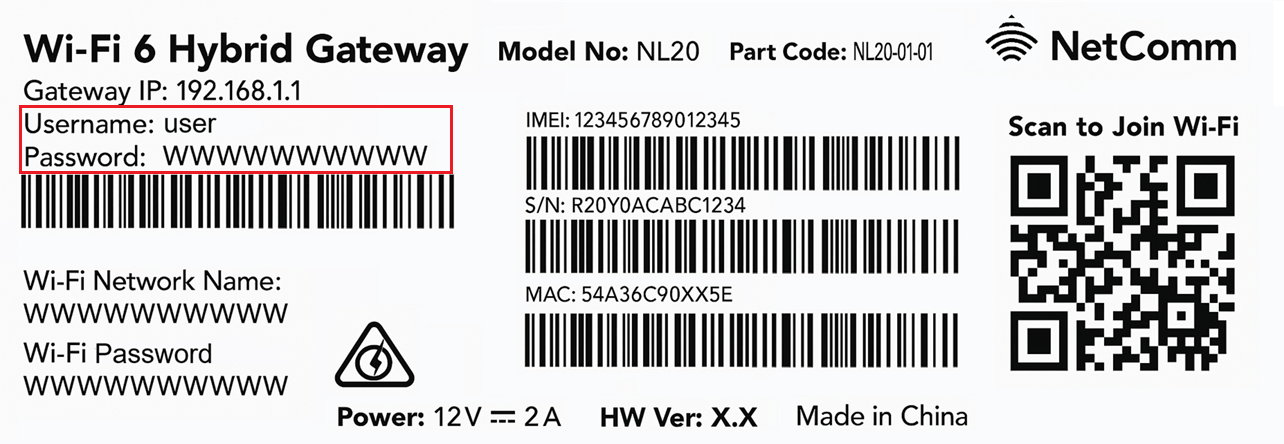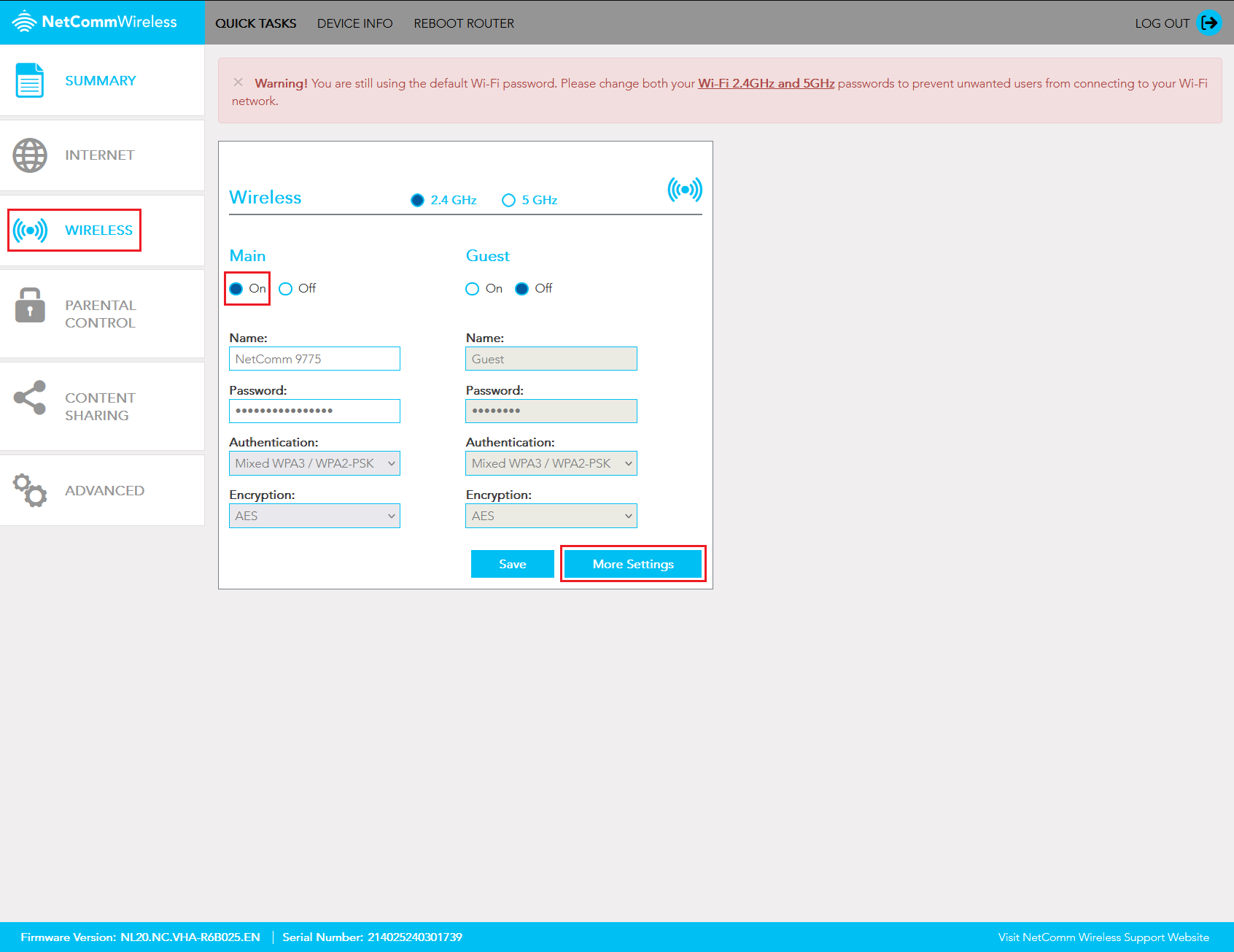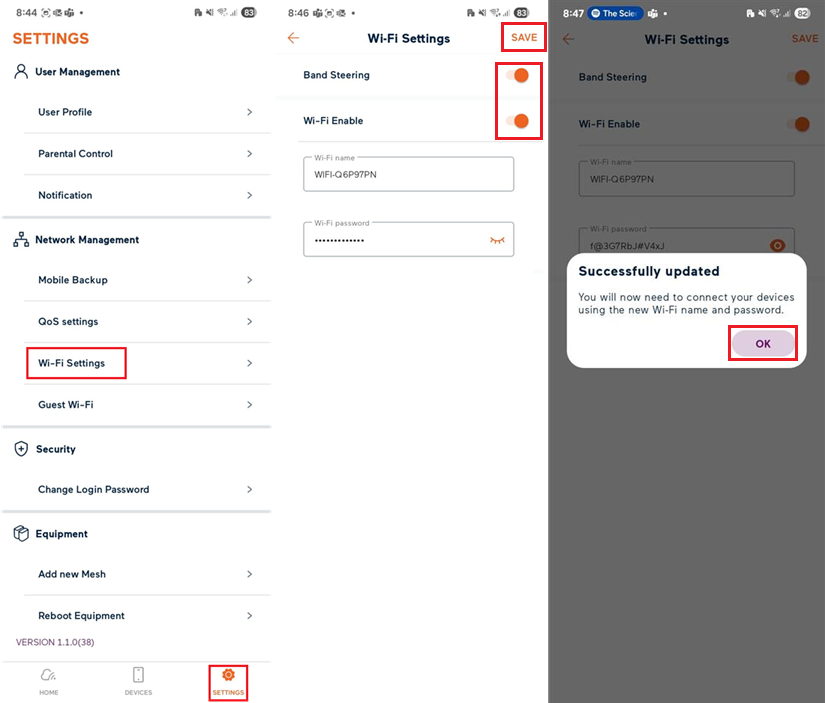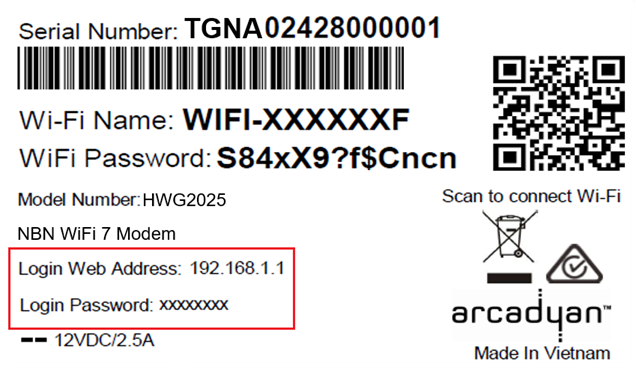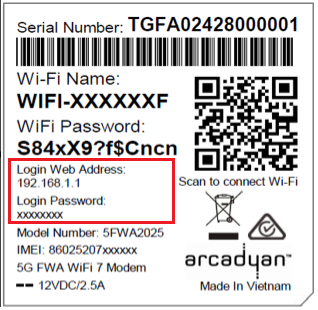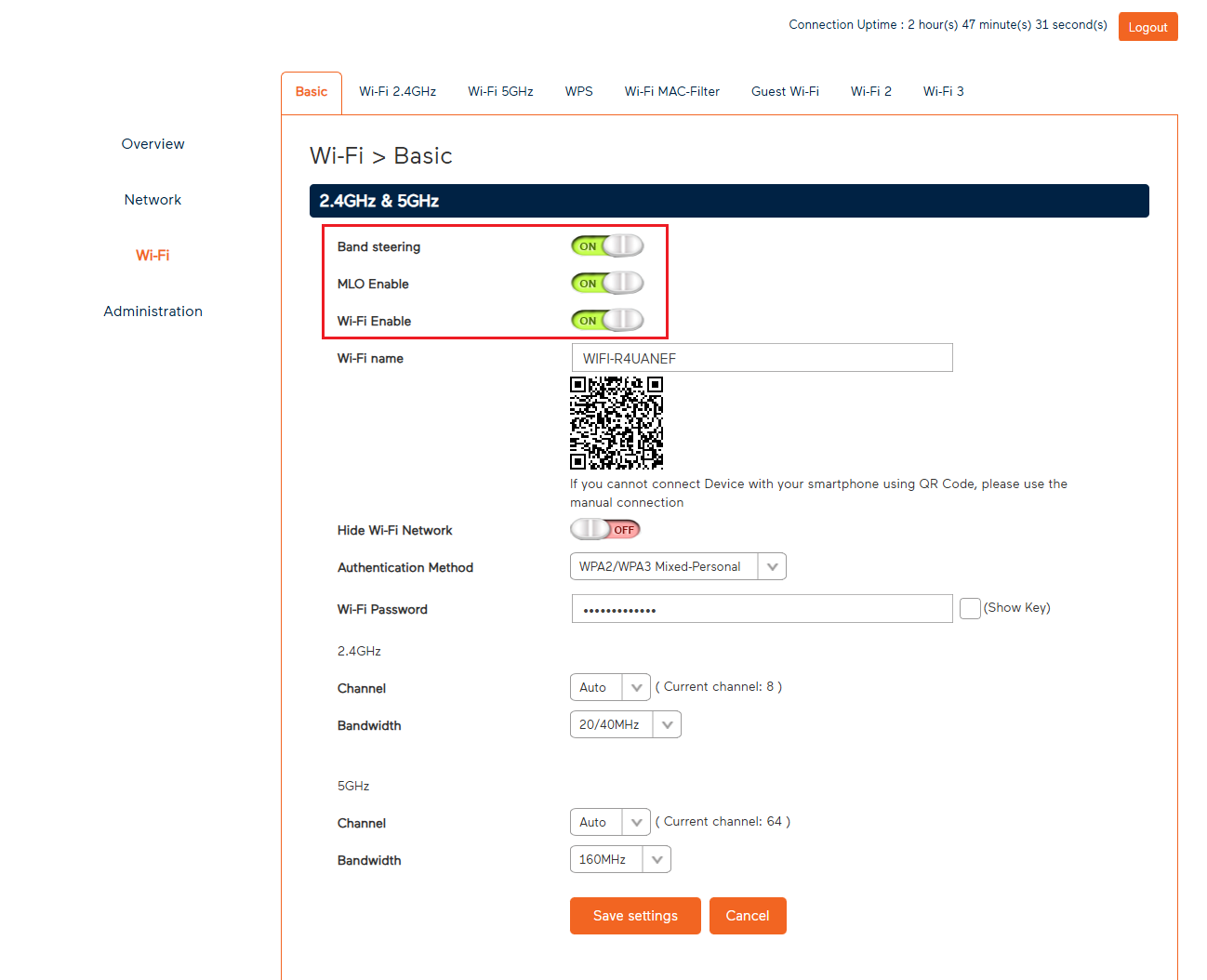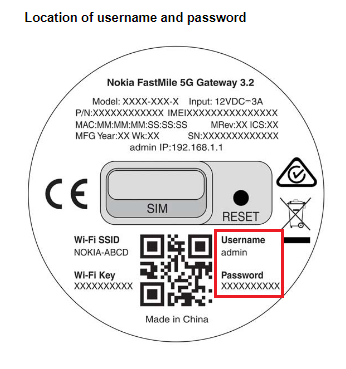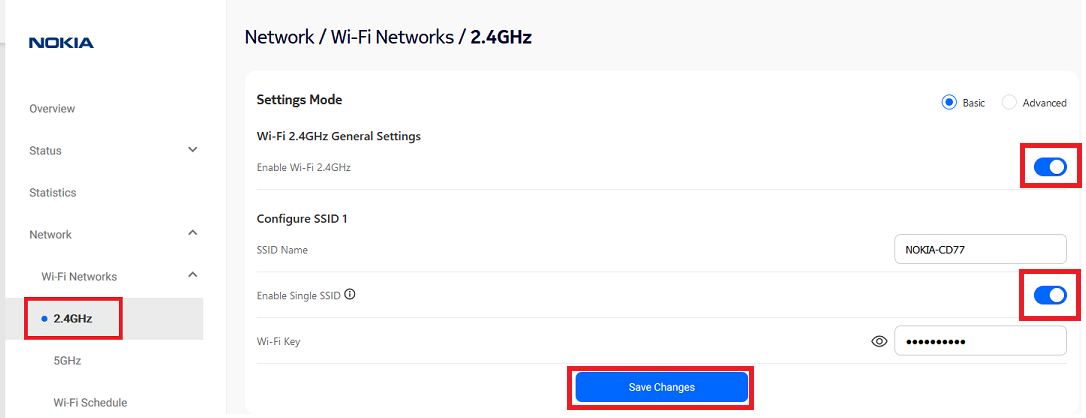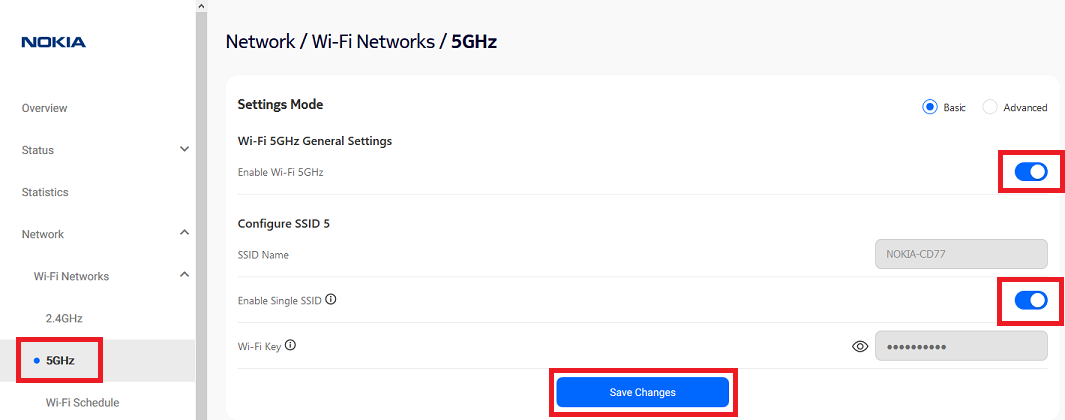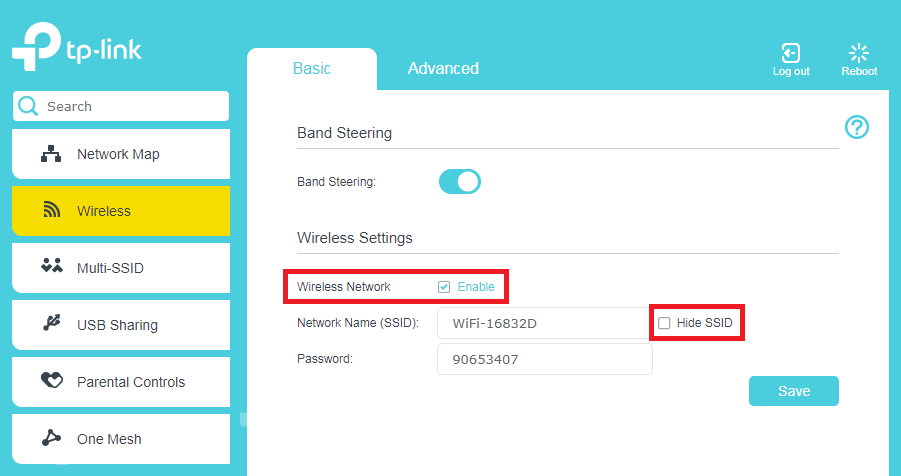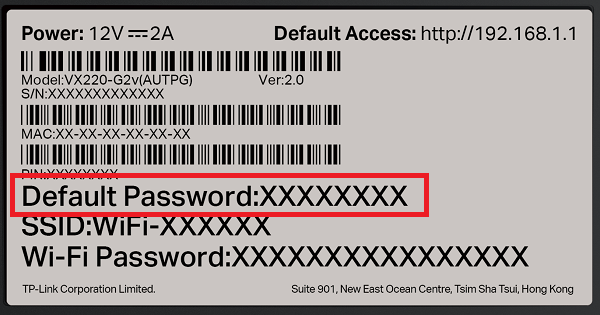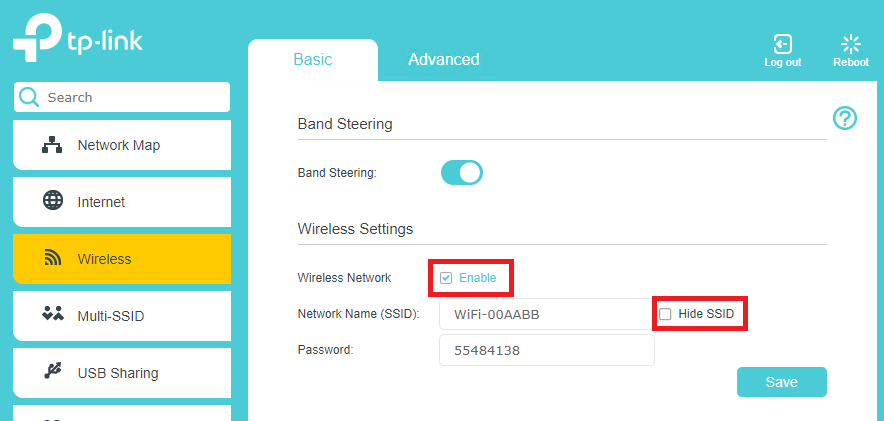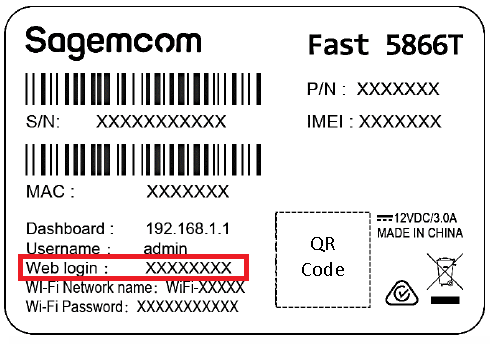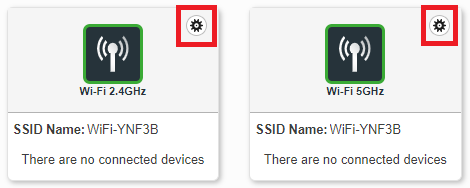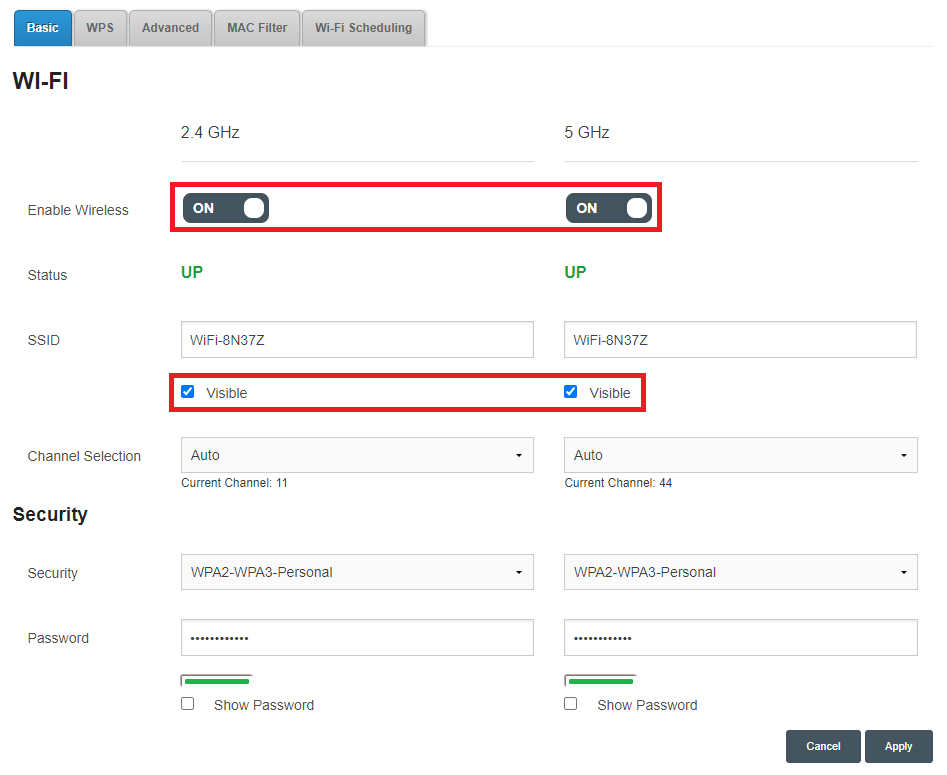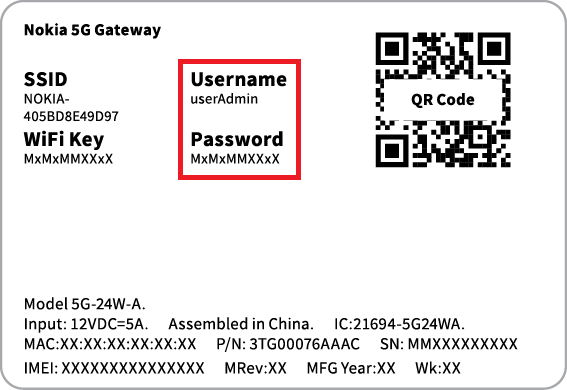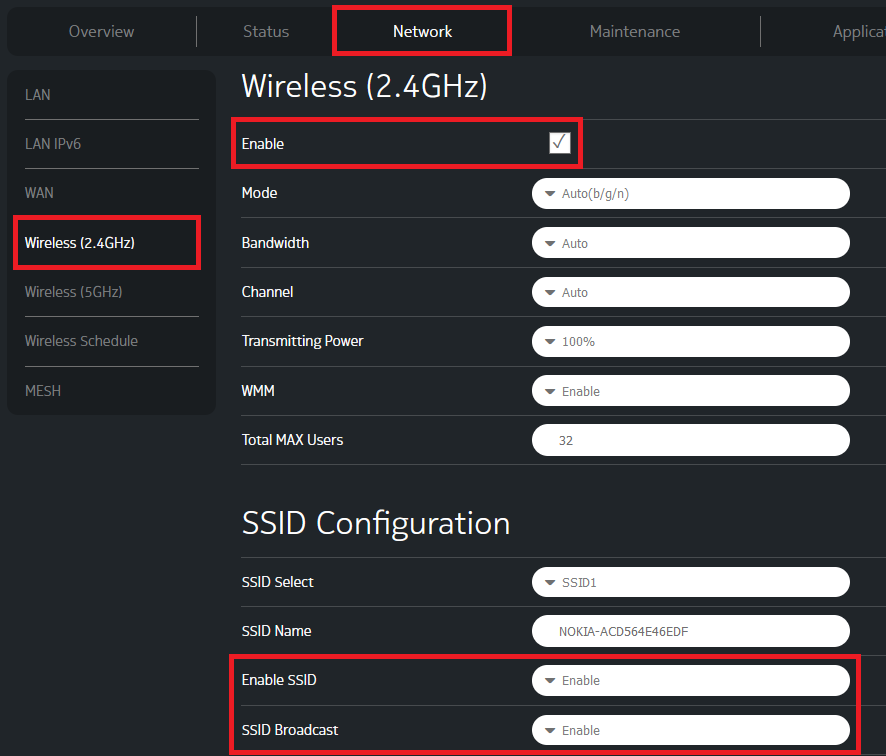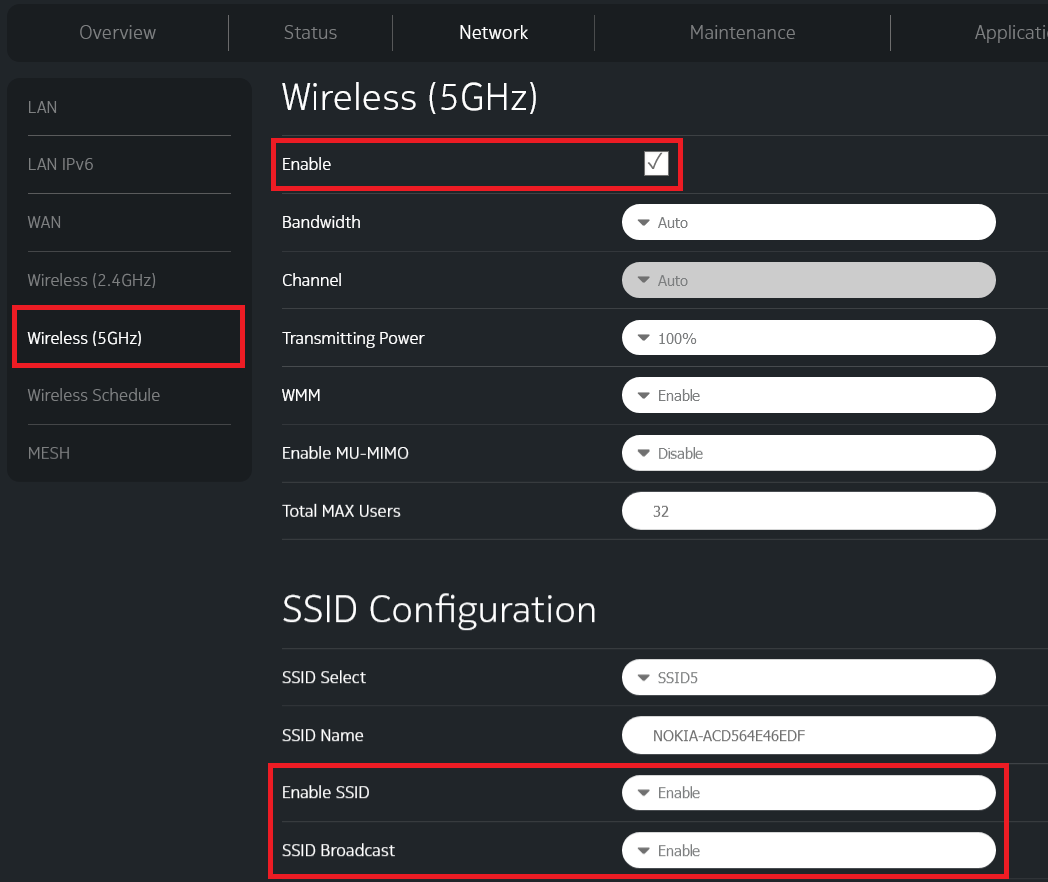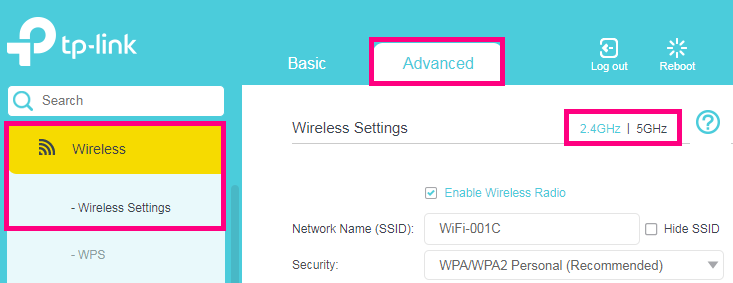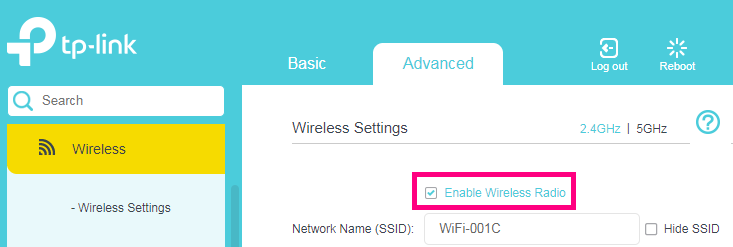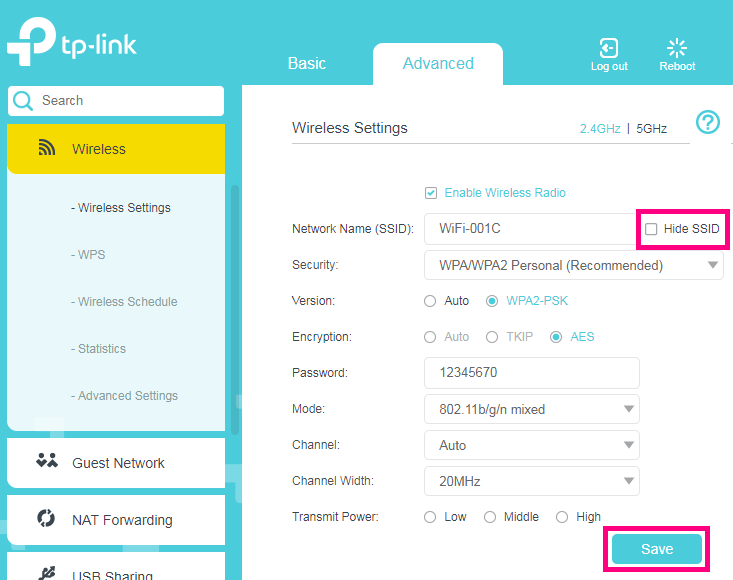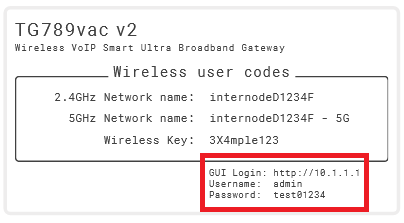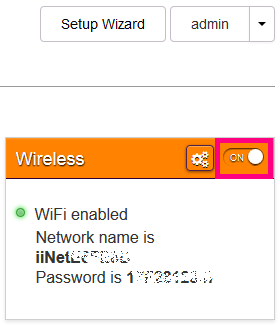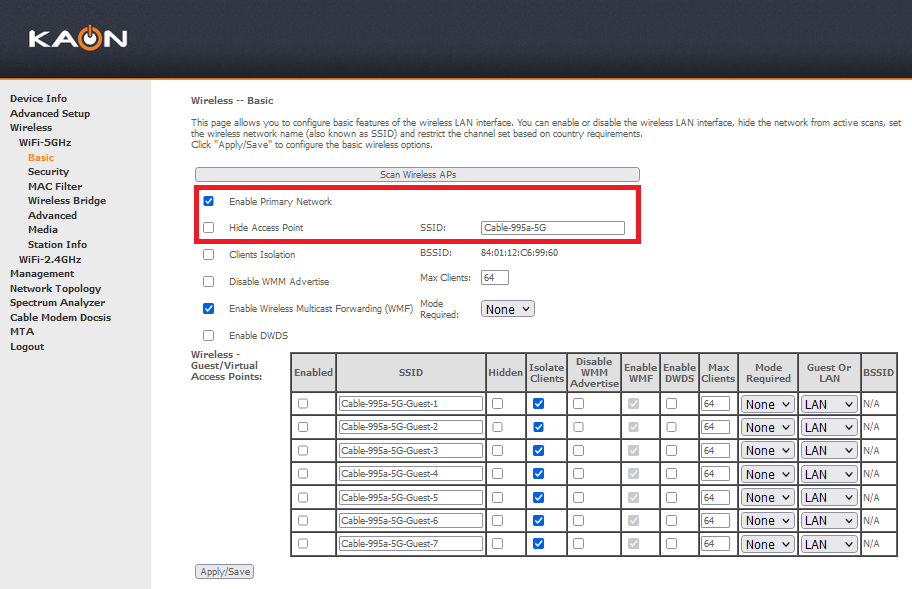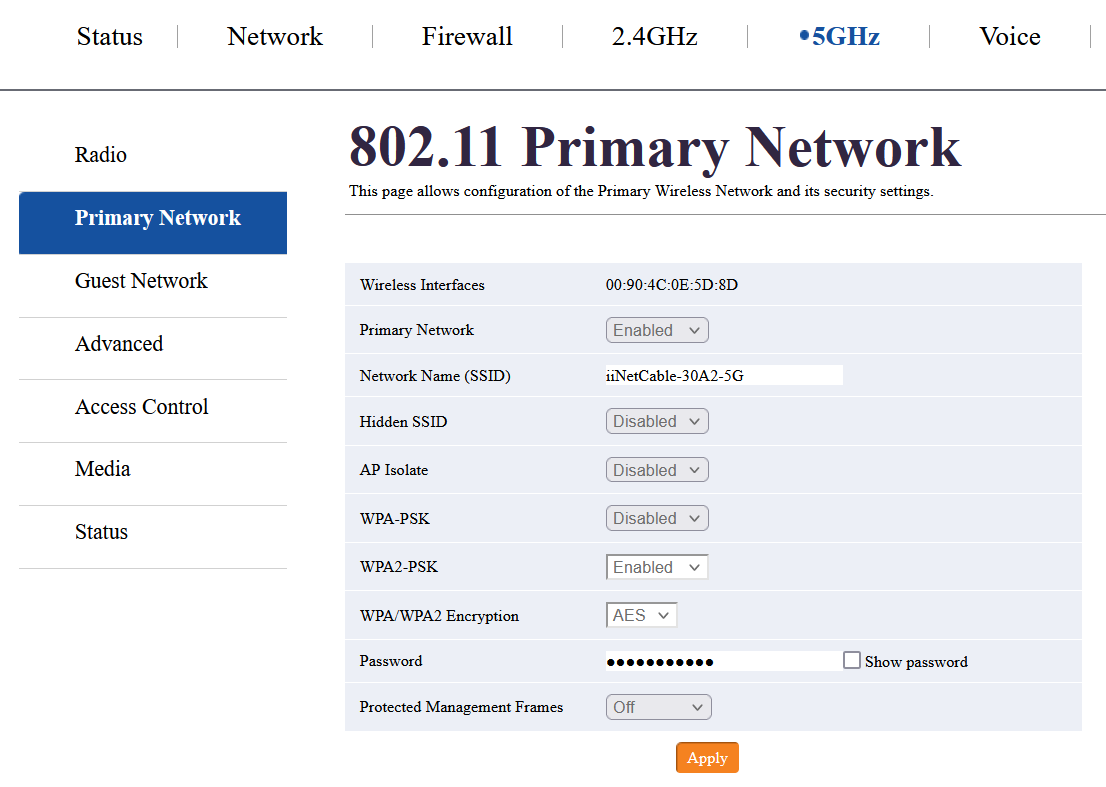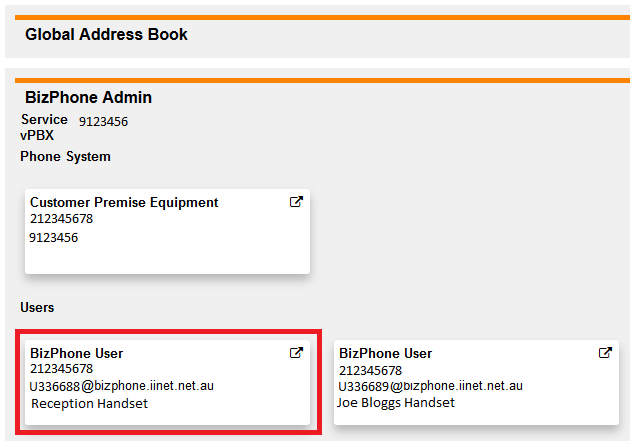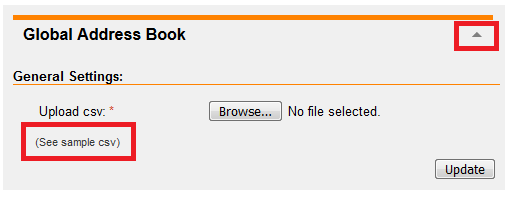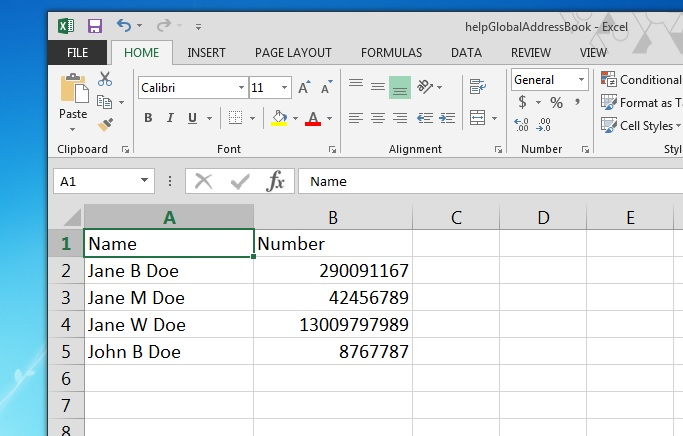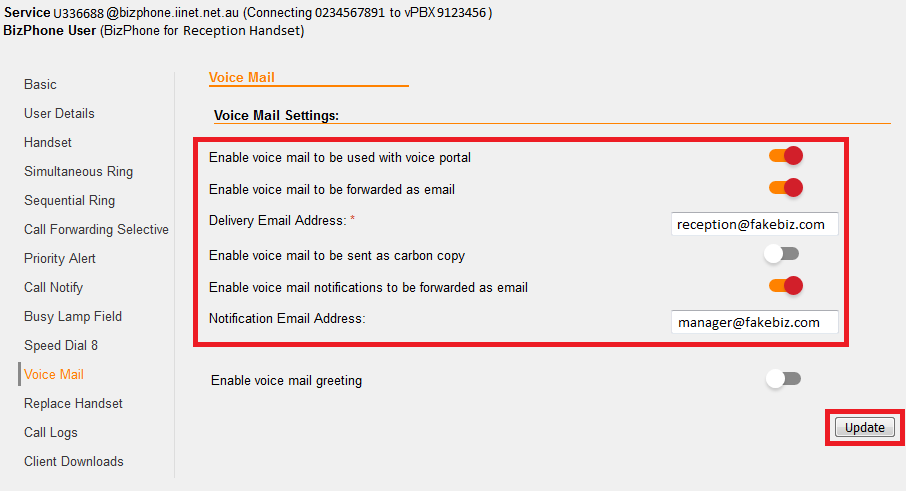Here's how to check your basic Wi-Fi settings on an iiNet modem. This will make sure Wi-Fi is turned on, confirm your Wi-Fi name and password, make sure your Wi-Fi name isn't hidden, and make sure any band steering is turned on.
Band steering is a feature that lets your devices automatically switch between 2.4GHz Wi-Fi and 5GHz Wi-Fi for the best Wi-Fi signal.
Don't have an iiNet modem? Check the manufacturer's website for a guide.
Choose your modem:
NetComm NL20 Modem
- Open your web browser and go to: http://192.168.1.1.
- Log in with the Username and Password found on the modem's barcode sticker or use your custom password.
- In the left pane, click Wireless.
- Select the 2.4GHz or 5GHz radio button.
- Make sure that Main is On, then select More Settings.
- Make sure that Hide SSID is Off.
- Make sure that 802.11ax-mode is On.
Note: You can enable WPS by selecting the On radio button next to WPS Function. - If you made any changes, hit Apply.
Wi-Fi Max Modem
From the My Internet Connect App
Don't want to use the app? You can do it in your web browser.
- Open the My Internet Connect App and tap Settings.
- Under Network Management, select Wi-Fi Settings.
- By default, Band Steering will be toggled ON, and you'll see one set of Wireless settings which will be applied to both the 2.4GHz and 5GHz Wi-Fi networks.
Note: If Band Steering is turned OFF, you will see separate 2.4GHz and 5GHz settings, and your devices will not automatically switch between the 5GHz/2.4GHz Wi-Fi networks depending on the best available signal. - Make sure that Wi-Fi Enable is toggled ON.
- On these pages, you'll also find the Wi-Fi name and Wi-Fi password.
- If you made any changes, click Save to finish.
From the Modem Dashboard
- Open your web browser and go to: https://192.168.1.1
- Log in with the Login Password found on the modem's barcode sticker or use your custom password.
- From the left pane, click Wi-Fi.
- By default, Band Steering will be toggled ON, and you'll see one set of Wireless settings which will be applied to both the 2.4GHz and 5GHz Wi-Fi networks.
If Band Steering is turned OFF, you will see separate 2.4GHz and 5GHz settings, and your devices will not automatically switch between the 5GHz/2.4GHz Wi-Fi networks depending on the best available signal. - Make sure that MLO Enable is toggled ON.
This feature allows devices to use multiple frequency bands for better performance. - Make sure that Wi-Fi Enable is toggled ON.
- Make sure that Hide Wi-Fi Network is toggled OFF. If the Wi-Fi network is hidden, then your Wi-Fi network name(s) won't show up in the list of available networks when you try to connect.
- If you made any changes, click Save to finish.
Wi-Fi Max 5G Modem
From the My Internet Connect App
Don't want to use the app? You can do it in your web browser.
- Open the My Internet Connect App and tap Settings.
- Under Network Management, select Wi-Fi Settings.
- By default, Band Steering will be toggled ON, and you'll see one set of Wireless settings which will be applied to both the 2.4GHz and 5GHz Wi-Fi networks.
If Band Steering is turned OFF, you will see separate 2.4GHz and 5GHz settings, and your devices will not automatically switch between the 5GHz/2.4GHz Wi-Fi networks depending on the best available signal. - Make sure that Wi-Fi Enable is toggled ON.
- On these pages, you'll also find the Wi-Fi name and Wi-Fi password.
- If you made any changes, click Save to finish.
From the Modem Dashboard
- Open your web browser and go to: https://192.168.1.1
- Log in with the Login Password found on the modem's barcode sticker or use your custom password.
- From the left pane, click Wi-Fi.
- By default, Band Steering will be toggled ON, and you'll see one set of Wireless settings which will be applied to both the 2.4GHz and 5GHz Wi-Fi networks.
If Band Steering is turned OFF, you will see separate 2.4GHz and 5GHz settings, and your devices will not automatically switch between the 5GHz/2.4GHz Wi-Fi networks depending on the best available signal. - Make sure that MLO Enable is toggled ON.
This feature allows devices to use multiple frequency bands for better performance. - Make sure that Wi-Fi Enable is toggled ON.
- Make sure that Hide Wi-Fi Networkis toggled OFF. If the Wi-Fi network is hidden, then your Wi-Fi network name(s) won't show up in the list of available networks when you try to connect.
- If you made any changes, click Save to finish.
Nokia FastMile 3.2 5G Modem
Note: The Enable Single SSID (band steering) feature can't be managed in the Nokia Wi-Fi app.
- On a device that's connected to your modem, open your web browser and go to: https://192.168.1.1
- Log in with the default username “admin” and the default password is on your modem's barcode sticker. If you have custom login details, use those instead.
- Hit Network.
- Select Wi-Fi Networks, then 2.4GHz.
- Make sure that Enable Wi-Fi 2.4GHz is ON.
- Make sure that Enable Single SSID and is ON.
If Enable Single SSID is ON, the Wi-Fi names (SSID Name) and passwords (Wi-Fi Key) must match for both 2.4GHz and 5GHz Wi-Fi – this lets devices automatically switch between networks for the best Wi-Fi signal. - If you made any changes, click Save Changes.
- Next, the same checks need to be made for the 5GHz Wi-Fi network. Select Wi-Fi Networks, then 5GHz.
- Make sure that Enable Wi-Fi 5GHz is ON.
- Make sure that Enable Single SSID and is ON.
- If you made any changes, hit Save Changes.
Smart Modem Gateway (VX420-G2H)
-
Open your web browser and go to: https://192.168.1.1
-
Log in with the default password “admin”. If you have a custom password, use that instead.
-
Select Wireless.
-
By default, Band Steering will be turned ON, and you'll see settings which that apply to both 2.4GHz and 5GHz Wi-Fi networks.
Note: If Band Steering is turned OFF, you will see separate 2.4GHz and 5GHz settings, and your devices will not automatically switch between networks for the best Wi-Fi signal. -
Make sure that Wireless Network - Enable is ticked.
-
Make sure that Hide SSID is NOT ticked.
If the SSID is hidden, then your Wi-Fi name(s) won't show up when you try to connect devices. -
On this page, you'll also find the Wi-Fi Name (Network Name SSID) and Password.
-
If you made any changes, hit Save.
VX220-G2V Modem
- Open your web browser and go to: https://192.168.1.1
- Log in with the default password found on your modem's barcode sticker. If you have a custom password, use that instead.
-
Select Wireless.
-
By default, Band Steering will be turned ON, and you'll see settings which that apply to both 2.4GHz and 5GHz Wi-Fi networks.
If Band Steering is turned OFF, you will see separate 2.4GHz and 5GHz settings, and your devices will not automatically switch between networks for the best Wi-Fi signal. -
Make sure that Wireless Network - Enable is ticked.
-
Make sure that Hide SSID is NOT ticked.
If the SSID is hidden, then your Wi-Fi name(s) won't show up when you try to connect devices. -
On this page, you'll also find the Wi-Fi Name (Network Name SSID) and Password.
-
If you made any changes, hit Save.
VX420-G2V Modem
-
Open your web browser and go to: https://192.168.1.1
-
Log in with the default password “admin”. If you have a custom password, use that instead.
-
Select Wireless.
-
By default, Band Steering will be turned ON, and you'll see settings which that apply to both 2.4GHz and 5GHz Wi-Fi networks.
Note: If Band Steering is turned OFF, you will see separate 2.4GHz and 5GHz settings, and your devices will not automatically switch between networks for the best Wi-Fi signal. -
Make sure that Wireless Network - Enable is ticked.
-
Make sure that Hide SSID is NOT ticked.
If the SSID is hidden, then your Wi-Fi name(s) won't show up when you try to connect devices. -
On this page, you'll also find the Wi-Fi Name (Network Name SSID) and Password.
-
If you made any changes, hit Save.
Sagemcom 5866
-
Open your web browser and go to: https://192.168.1.1
-
Log in with the default username “admin” and the default password on your modem's barcode sticker. If you have custom login details, use those instead.
- Select the cog icon on the Wi-Fi 2.4GHz or 5GHz panel.
-
Make sure that Enable Wireless is set to ON for both 2.4GHz and 5GHz Wi-Fi networks.
-
Make sure that Visible is ticked for both 2.4GHz and 5GHz Wi-Fi networks.
If this box is not ticked, then your Wi-Fi names won't show up when you try to connect devices. -
On this page, you'll also find the Wi-Fi names (SSID) and Passwords.
-
If you made any changes, hit Apply.
Nokia FastMile R1 5G Modem
-
Open your web browser and go to: https://192.168.1.254
-
Log in with the default username “userAdmin” and the default password on your modem's barcode sticker. If you have custom login details, use those instead.
-
Hit Network, then Wireless (2.4GHz).
-
Make sure that Enable is ticked.
-
Make sure that Enable SSID and SSID Broadcast are both set to Enable.
If SSID Broadcast is disabled, then your Wi-Fi names won't show up when you try to connect devices. -
If you made any changes, hit Save.
-
Next, the same checks need to be made for the 5GHz Wi-Fi network. Select Wireless (5GHz).
-
Make sure that Enable is ticked.
-
Make sure that Enable SSID and SSID Broadcast are both set to Enable.
-
On these pages, you'll also find the Wi-Fi names (SSID Name) and Passwords (WPA Key).
Important: Make sure the names and passwords match for both 2.4GHz and 5GHz – this lets devices automatically switch between networks for the best Wi-Fi signal. -
If you made any changes, hit Save.
TP-Link VR1600v
-
Open your web browser and go to: https://192.168.1.1
-
Log in with the default username "admin" and default password “admin”. If you have custom login details, use those instead.
- Select Advanced, then Wireless > Wireless Settings.
- By default, you'll see the settings for the 2.4GHz Wi-Fi network. You can switch between 2.4GHz and 5GHz settings using the tabs in the upper right corner.
- Make sure that Enable Wireless Radio is ticked for both 2.4GHz and 5GHz Wi-Fi.
-
Make sure that Hide SSID is NOT ticked for either 2.4GHz or 5GHz Wi-Fi.
If the SSID is hidden, then your Wi-Fi names won't show up when you try to connect devices. -
On these pages, you'll also find the Wi-Fi name (Network Name SSID) and Password.
-
If you made any changes, hit Save.
TG-789 Broadband Gateway
- Open your web browser and go to: https://10.1.1.1
- Log in with the unique default password printed on the modem's barcode sticker (example below) or use your custom login details.
- On the dashboard, make sure the switch in the corner of the Wireless panel is set to ON.
- Click the cog/gears icon next to it to open the Wireless settings, then click Show advanced in the top-right corner.
- Scroll down. Under Access Point, make sure Broadcast SSID is set to ON. If this switch it set to OFF, then your Wi-Fi network name won't show up in the list of available networks when you try to connect.
- On this page, you'll also find the Wi-Fi network name (SSID name) and Wireless Password.
- If you made any changes, click Save to finish.
Cable Gateway Pro (CG3000)
- Open your web browser and go to: http://192.168.0.1
- Log in with the username "admin" and the unique default password found on your modem's barcode sticker, or use your custom password.
- Select Wireless > WiFi-5GHz > Basic.
Using the 5GHz Wi-Fi network is recommended for the best performance. If you have older Wi-Fi devices and need to check the 2.4GHz Wi-Fi network, select Wireless > WiFi-2.4GHz > Basic instead. - Make sure Enable Primary Network is ticked.
- Make sure Hide Access Point is not ticked. If the access point is hidden, then your Wi-Fi network name won't show up in the list of available networks when you try to connect.
- On this page, you'll also find the Wi-Fi Network Name (SSID).
- If you made any changes, hit Apply/Save to finish.
Cable Gateway Pro (CG2200)
- Open your web browser and go to: http://192.168.0.1
- Log in with the default username "admin" and default password “admin”, or use your custom login details.
- On the menu bar, you'll see options for both the 2.4GHz network and 5GHz network. Select the network you use (5GHz is recommended).
- Select Primary Network.
- Make sure Primary Network is set to Enabled.
- Make sure Hidden SSID is set to Disabled. If Hidden SSID is enabled, then your Wi-Fi network name won't show up in the list of available networks when you try to connect.
- On this page, you'll also find the Wi-Fi Network Name (SSID) and Password.
- If you made any changes, hit Apply to finish.
Cable Gateway Pro (EPC3940L)
- Open your web browser and go to: http://192.168.0.1
- Log in with the default username "admin" and default password “password”, or use your custom login details. If this fails, try leaving both fields blank.
- On the dashboard, click the blue Wireless panel.
- On the Wireless Configuration page, you'll see settings for both the 2.4GHz network and 5GHz network. Make sure Wireless Network is set to ON for the network you use.
- On this page, you'll also find the Wi-Fi Network Name and Password (Wireless Passphrase).
- If you made any changes, click Save Settings to finish.
This feature is only available on Bizphone Standard and Premium handsets.
Select one of the links below to jump to a query:
Busy Lamp Field Features
Busy Lamp Field allows you to watch that status of another user that is assigned to your group, call other users in your group, or transfer calls to those users.
View User Status
Standard Handsets (T43U, T42S. or T42G)
- Entries and their associated DSS keys are on the left and right of your screen.
- A green light indicates that user is available.
- A red light indicates that user is busy.
Premium Handsets (T48U, T48S or T48G)
- Entries are on the left and right of your screen. Press More+ in the bottom right corner to view all entries.
- A green head next to the entry indicates that user is available.
- A red head next to the entry indicates that user is busy.
Transfer to Users
- During a call, select BLF entry for a user.
- Press the Transfer soft key for a semi-attended transfer; OR
- Wait for user to pick up, then press Transfer for an attended transfer.
Call Barge
- When you see a user is busy on a call (red light/head), select the user.
- A three-way conference will begin.
- To leave the conference, hang up.
Setting up Busy Lamp Field
- Log in to Frontier Portal. If you have never logged in before, please watch this video.
- Select the desired BizPhone user to edit.
- Select Busy Lamp Field.
- Select a user and use the right arrow button to assign them to Assigned BizPhone Users. This adds the user to the busy lamp field.
- To reverse this, select a user and use the left arrow button to assign them to Available BizPhone Users. This removed the user from the busy lamp field.
- Select Update to save your changes.
- You may need to restart your handset for changes to take effect.
BizPhone's Call Park feature allows you to:
- Park a call on any BizPhone handset or SoftPhone. Once a call is park, the handset can be hung up without terminating the call.
- Retrieve a parked call using any BizPhone handset or SoftPhone on your system.
Select one of the links below to jump to a query:
- Parking a call
- Retrieving a Parked call
- Call Park Retrieve using Line/DSS keys (Standard & Premium handsets only)
Parking a call
- During a call, press the Transfer soft key (or Options soft key > Transfer on a Cordless handset).
- Dial *68 and listen for the IVR announcement.
- Dial # to park the call at your current handset, or dial the last 5 digits of the phone number for the handset you wish to park at.
- The call is now parked and you may hang up.
Retrieving a Parked call
- Dial *88.
- Dial # to retrieve the call parked at your current handset, or dial the last 5 digits of the phone number for the handset you wish to retrieve the parked call from.
- The call is now retrieved.
Call Park Retrieve using Line/DSS keys (Standard & Premium handsets only)
Line keys are found on the left and right sides of the screen on a T42S Standard handset. A maximum of 15 can be created.
DSS keys are found on the left and right sides of the Home screen on a T48S Premium handset. You can press the DSS Keys soft key to view all DSS Keys.
These setup processes must be followed on every handset in order to use the DSS key options.
Set up Call Park
- Find and hold down a blank Line/DSS key on your handset.
Note: On a T42S handset, if you cannot find a blank Line key, select Menu > Features > DSS Keys, then select an available key. - Use the left and right arrow keys to select Speed Dial.
- Use the down arrow key to go to step 2 on the setup screen.
- Select any Line (Line 1 is default).
- Use the down arrow key to go to step 3 on the setup screen.
- Use the dial keys to name your DSS key. This must be "P" followed by the handset's full phone number or 5-digit extension, e.g. "P12345" or "PRecep".
- Use the down arrow key to go to step 4 on the setup screen.
- Set the Value to *68 followed by the DSS key name you assigned without the "P", e.g. "*6812345".
- Select Save.
Set up Call Retrieve
- Find and hold down a blank Line/DSS key on your handset.
Note: On a T42S handset, if you cannot find a blank Line key, select Menu > Features > DSS Keys, then select an available key. - Use the left and right arrow keys to select Retrieve Park.
- Use the down arrow key to go to step 2 on the setup screen.
- Select the same Line as the one chosen for Call Park.
- Use the down arrow key to go to step 3 on the setup screen.
- Use the dial keys to name your DSS key. This must be "R" followed by the handset's full phone number or 5-digit extension, e.g. "R12345" or "RRecep".
- Use the down arrow key to go to step 4 on the setup screen.
- Set the Value to the DSS key name you assigned without the "R", e.g. "12345".
- Select Save.
Using DSS keys
- During a call, select the Transfer soft key.
- Select the DSS key assigned to the location you wish to park at, e.g. "P12345" or "PRecep".
- The call will be parked and you may hang up.
- To retrieve a call, select the DSS key assigned to the location you wish to retrieve from, e.g. "R12345" or "RRecep".
- The call will be retrieved.
If you suspect your phone number has been stolen, you should take action as soon as possible.
Someone might have stolen your mobile number if you suddenly can't use your mobile service, or you see "SOS" instead of reception bars.
Select one of the links below to jump to a query:
- What to do if you suspect your mobile number has been stolen
- How someone can steal your number
- How we can help
What to do if you suspect your mobile number has been stolen
- Check your if your mobile service has Ported Out status in Toolbox.
- Check your email for any notifications from iiNet about a mobile service transfer.
- Contact us as soon as possible.
We also recommend that you:
- Contact your bank or financial institution straight away and tell them someone might be committing fraud;
- Consider changing your passwords for accounts such as your bank, email and social media;
- Report any fraud to local police or the Australian Federal Police;
- Report any cybercrime relating to identity theft and online fraud to the Australian Cyber Security Centre;
- Contact IDCARE on 1300 432 273 if you want help with identity crime or cyber security;
- Report the activity to Scamwatch.
How someone can steal your number
If a criminal has your personal information, they can steal your mobile number in a couple of ways:
- An unauthorised port - the criminal contacts a new telco and pretends to be you, sets up an account and ports your number.
- A SIM swap - the criminal contacts your current telco pretending to be you and requests a new SIM that has your number.
Once a criminal has your number, they can receive SMS verification codes. This means they can get access to services such as your bank, email and social media.
How we can help
If someone ported your number without your consent, we can reverse the port.
If someone made a SIM swap without your consent, we can deactivate the SIM and provide you a new one.
Before a mobile number is ported, iiNet carries out additional validation checks to ensure the port is authorised. We send a unique verification code via SMS to the affected mobile number. This verification code is required to authorise a porting request, which helps to protect our customers from having their mobile numbers stolen.
Global Address Book allows up to 500 contacts to be uploaded and accessed by Standard, Premium or Cordless handsets.
This feature is not available for SoftPhone or Desktop/Mobile clients.
Select one of the links below to jump to a query:
- Creating a Global Address Book file
- Error messages when uploading your .CSV file
- Accessing the Global Address Book from your handset
Creating a Global Address Book file
- Log in to Frontier Portal. If you have never logged in before, please watch this video.
- Select the arrow next to Global Address Book to expand this section.
- Select See sample csv and save the file to a familiar location on your computer.
- Open the sample CSV file using Microsoft Excel. Adjust the example entries and add more names and phone numbers as desired.
Note: Landline phone numbers must include the prefix for the area code, e.g. "02" for NSW. A maximum of 500 entries is supported. - Save the spreadsheet as a .CSV (comma delimited) file.
- Return to Frontier Portal. Under Global Address Book, select Browse.
- Locate and select your .CSV file, then select Update.
Note: You can update an existing Global Address book file in the same way. - You must restart your BizPhone handset(s) after any changes in order to access the updated Global Address Book.
Error messages when uploading your .CSV file
If you encounter an error when uploading your file:
Please ensure that your .CSV file:
- Has no more than 500 contacts in total.
- Does not exceed 50 characters per Name field.
- Contains no special characters i.e: .~!@#$%^&*()_+-=[]{}|\:'<>?,./
- Contains no double spaces e.g. “John Doe”.
- Contains no leading/lagging spaces in the Name field e.g. " Name" or "Name ".
Resolving these file issues should allow you to upload successfully. If you encounter an error you cannot resolve, please call us on 13 86 89 for assistance.
Accessing the Global Address Book from your handset
Cordless DECT Handsets (W76P, W60P or W56P)
- Press the OK handset key.
- Use the Up and Down handset keys to find Directory, then press OK.
- Select Network Dir.
- Select GroupCommon.
- Select the desired Name and Phone number from the Global Address Book.
Standard Handsets (T43U, T42S. or T42G)
- Press the Directory soft key.
- Use the Up and Down handset keys to find and select Group Common.
- Select the desired Name and Phone number from the Global Address Book.
Premium Handsets (T48U, T48S or T48G)
- Select Directory on the main LCD screen.
- Select Group Common from the left-hand menu.
- Select the desired Name and Phone number from the Global Address Book.
How do I modify features like Call Forwarding?
We have built a web interface (Frontier Portal) that allows you to access and modify features of your BizPhone service. Some features can also be modified using the handset and special codes.
How fast does my Internet connection need to be?
Continuing on from the discussion of bandwidth in the previous question, we recommend a minimum of 100kbps of upload speed per concurrent call.
What type of cabling is required?
How do I connect my computer and phone? Your new telephone will plug into your switch via a standard Ethernet cable. Your computer can be routed directly to the switch or can also plug into the phone. The advantage of this feature is that only one port and run of cable is needed to connect both your phone and computer.
Does the phone need its own power supply?
All of the BizPhone handsets come with power pack which plugs into a standard 240v wall socket. These handsets also have the Power over Ethernet (PoE) function. This allows the handsets to be powered via the Ethernet cable it is connected to. For this setup to work correctly, you must have a PoE switch installed in your business.
Does the ATA need a power supply?
Yes, BizPhone over ATA requires a power supply. The use of these features on BizPhone ATA is not guaranteed and the device will not function in the event of a power outage.
Does the ATA support Fire Alarms, Back to Base alarms and lift emergency services?
Please note, while BizPhone ATA does support Fire Alarms, Back to Base alarms and lift emergency services on a best effort basis, BizPhone ATA also requires a power supply. The use of these features on BizPhone ATA is not guaranteed and the device will not function in the event of a power outage.
Can I connect my fax machine?
Fax is supported on a best effort basis only. You can order a BizPhone Line (ATA) plan and plug a fax machine into it, but we cannot guarantee that fax will always work on ATA, as it is a VoIP based service.
Can I dial 000, and does my 000 emergency address work?
Yes - access to the emergency services is still available. Please consider that as your BizPhone service can be used in any location that has a suitable Internet connection, the address recorded against your phone number that emergency services sees when you call may not match your current physical location. A caller to emergency services should always have access to their physical address to give to the operator.
Can I customise the recorded 'Music On Hold'?
Yes, the ability to upload or record your own 'Music On Hold' is enabled through the online portal.
What type of calls are included for free in my monthly line rental?
Each plan with iiNet BizPhone includes all of your local, national, and mobile calls at no additional cost.
Does iiNet BizPhone support multiple sites or physical locations?
Yes, iiNet BizPhone support multiple sites or physical locations as part of same BizPhone order.
What is the process for returning the old BizPhone handset when I change my BizPhone plan?
The iiNet equipment retrieval team will initiate the collection of the old equipment by sending the consignment note to you and organising the courier to pick it up.
Do I need to do anything on the portal to activate the new handset (upgrade or downgrade) or is it simply plug and play?
You will need to plug in the handset once you receive it and then call the BizPhone provisioning/activation team to activate the new handset against your existing service.
How do I reconfigure the phone if an employee leaves the business?
The group Administrator can log into online portal to change the first and last name details of that user.
What is the maximum monitored users in the Busy Lamp Field feature?
The maximum limit is 50 users.
What is the maximum monitored users for Receptionist Basic vs Advanced?
For Basic, it is a max of 30 monitored users and for Advanced it is 200 statically or 100 dynamically monitored users.
Is the Speed Dial 8 feature available on the IP DECT Phone? What about Softphone?
Yes, Speed Dial 8 is available on both the DECT Phone and the Softphone.
Is the Auto Attendant audio file format restricted?
Are there any guidelines for this? Yes, there is a specification for the Auto Attendant audio file format, which you can find in the iiNet BizPhone User Reference Guide.
Is the Busy Lamp Field feature available across all different handsets?
The Busy Lamp Field feature is not available on the Cordless IP DECT (W76P, W60P and W56P) handset. It is only available on the Standard (T43U, T42S, T42G) and Premium (T48U, T48S, T48G) handsets.
Is the Voicemail to Email feature available on iiNet BizPhone service?
Yes, the Voicemail to Email feature is available and the email address will be captured at the time of ordering. You can also modify this feature through the online portal.
Can I add extra lines to my BizPhone handsets?
No, iiNet BizPhone is 1-to-1 service and you can only have 1 phone number or line on each handset.
Are calls that are initiated from the BizPhone Mobile App charged to the BizPhone user (i.e. not to the user’s mobile carrier)?
Calls that are made from the BizPhone Mobile App are charged to the BizPhone user at the same rate as those from the desktop phones.
Note: if WiFi is not on or available at the time of making call, it will use the mobile carrier’s data plan.
The following types of call transfers may be used on a BizPhone Standard T42S (or SoftPhone), Cordless W60P or Premium T48S handset:
- Blind Transfer - Transfer a call directly to another party without prior consulting.
- Semi-Attended Transfer - Transfer a call to another party whilst the target transfer phone is ringing.
- Attended Transfer - Transfer a call to after consulting with the receiving party.
Select one of the links below to jump to a query:
- Call Transfer on Cordless Handsets (W76P, W60P or W56P)
- Call Transfer on Standard Handsets inc SoftPhone (T43U, T42S. or T42G)
- Call Transfer on Premium Handsets (T48U, T48S or T48G)
Call Transfer on Cordless Handsets (W76P, W60P or W56P)
Blind Transfer
- Press the Options soft key during a call, then select Transfer.
- Enter the number you want to transfer the call to.
- Press the Transfer soft key to complete the transfer.
Semi-Attended Transfer
- Press the Options soft key during a call, then select Transfer.
- Enter the number you want to transfer the call to. Note that this selection may be done using the Directory soft key > Local Directory if desired.
- Press OK or the handset's Call button to dial out.
- When you hear the receiving line ringing, press the Transfer soft key to complete the transfer.
Attended Transfer
- Press the Options soft key during a call, then select Transfer.
- Enter the number you want to transfer the call to. Note that this selection may be done using the Directory soft key > Local Directory if desired.
- Press OK or the handset's Call button to dial out.
- After the party answers the call and you have consulted with them, press the Transfer soft key to complete the transfer.
Note: If you are using a handset, the transfer can be completed by hanging up. You can cancel the transfer before the call is connected by pressing the Cancel soft key.
Call Transfer on Standard Handsets inc SoftPhone (T43U, T42S. or T42G)
Blind Transfer
- Press the Transfer soft key during a call.
- Enter the number you want to transfer the call to.
- Press the Transfer soft key to complete the transfer.
Semi-Attended Transfer
- Press the Transfer soft key during a call.
- Enter the number you want to transfer the call to. Note that this selection may be done using the Directory soft key > Local Directory or History if desired.
- Press OK to dial out.
- When you hear the receiving line ringing, press the Transfer soft key to complete the transfer.
Attended Transfer
- Press the Transfer soft key during a call.
- Enter the number you want to transfer the call to. Note that this selection may be done using the Directory soft key > Local Directory or History if desired.
- Press OK to dial out.
- After the party answers the call and you have consulted with them, press the Transfer soft key to complete the transfer.
Note: If you are using a handset, the transfer can be completed by hanging up. You can cancel the transfer before the call is connected by pressing the Cancel soft key.
Call Transfer on Premium Handsets (T48U, T48S or T48G)
Blind Transfer
- Press the handset's Transfer button or the Transfer soft key during a call.
- Enter the number you want to transfer the call to.
- Press the Transfer soft key to complete the transfer.
Semi-Attended Transfer
- Press the handset's Transfer button or the Transfer soft key during a call.
- Enter the number you want to transfer the call to. Note that this selection may be done using the Directory soft key > All Contacts or Remote Phone Book, or the History soft key if desired.
- Press OK or select the desired contact/phone number to dial out.
- When you hear the receiving line ringing, press the handset's Transfer button or the Transfer soft key to complete the transfer.
Note: If you are using a handset, the transfer can be completed by hanging up.
Attended Transfer
- Press the handset's Transfer button or the Transfer soft key during a call.
- Enter the number you want to transfer the call to. Note that this selection may be done using the Directory soft key > All Contacts or Remote Phone Book, or the History soft key if desired.
- Press OK or select the desired contact/phone number to dial out.
- After the party answers the call and you have consulted with them, press the handset's Transfer button or the Transfer soft key to complete the transfer.
Note: If you are using a handset, the transfer can be completed by hanging up. You can cancel the transfer before the call is connected by pressing the Cancel soft key.
Call forwarding is available for standard Australian landline or mobile numbers. You cannot forward calls to international, 13/1300/1800 or premium numbers.
Call Forward handset quick codes
| Action | Dial quick code |
|---|---|
| Activate Call Forward Busy (forward when phone is engaged) |
*90 <PHONE NUMBER> |
| Deactivate Call Forward Busy | *91 |
| Activate Call Forward No Answer (forward when call is not answered) |
*92 <PHONE NUMBER> |
| Deactivate Call Forward No Answer | *93 |
| Activate Call Forward Immediate (forward calls immediately) |
*72 <PHONE NUMBER> |
| Deactivate Call Forward Immediate | *73 |
| Activate Call Forward Not Reachable (forward when phone is offline, inactive or faulty) |
*94 <PHONE NUMBER> |
| Deactivate Call Forward Not Reachable | *95 |
Call Forward settings via Frontier Portal
- Log in to Frontier Portal. If you have never logged in before, please watch this video.
- Select the desired BizPhone user to edit.
- Select Basic.
- Under "Call Forward", set the switches for the desired call forwarding options (No Answer, Busy, Immediate or Not Reachable) to ON if you wish to enable them, or OFF if you wish to disable them.
- Enter the phone number to forward calls to for each enabled option.
- Hit Update at the bottom of the screen to save.
BizPhone handsets/users are pre-configured to accept and play back voice mail messages by default. This guide will cover how to listen to voice mail, change your greeting, and forward voice mails to email.
Select one of the links below to jump to a query:
- Listening to voice mail
- Setting a new voice mail greeting via the handset
- Setting a new voice mail greeting via Frontier Portal
- Forwarding voice mail to email via Frontier Portal
Listening to voice mail
- Press the envelope button/icon ✉ on your BizPhone handset or softphone. If you are a BizPhone ATA line user, dial *62 instead.
- Enter your voice mail passcode. If you don't know your passcode, please see this guide.
- Press 1 to enter your voice mail box.
- Press 1 to listen to your messages.
Setting a new voice mail greeting via the handset
- Press the envelope button/icon ✉ on your BizPhone handset or softphone. If you are a BizPhone ATA line user, dial *62 instead.
- Enter your voice mail passcode. If you don't know your passcode, please see this guide.
- Press 1 to enter your voice mail box.
- To set a Busy greeting (played when you are already on a call) press 2. To set a No answer greeting (played when the call is not answered) press 3.
- Follow the voice prompts to record and save your greeting.
Setting a new voice mail greeting via Frontier Portal
Your audio file must meet the following specifications:
| Audio file format | Specifications |
|---|---|
| .WAV |
|
| .WMA |
|
| Both .WAV and .WMA |
|
If required, click here to search for online audio conversion sites to find one that best suits you.
- Log in to Frontier Portal. If you have never logged in before, please watch this video.
- Select the desired BizPhone user to edit.
- Select Voice mail.
- Set the Enable voice mail greeting switch to ON.
- Select Upload new media file and use the Browse button to select your audio file.
- Hit Update to save.
Forwarding voice mail to email via Frontier Portal
- Log in to Frontier Portal. If you have never logged in before, please watch this video.
- Select the desired BizPhone user to edit.
- Select Voice mail.
- Set the Enable voice mail to be forwarded as email switch to ON.
- Enter the Delivery email address.
- (Optional) If you wish to forward voice mail to additional email addresses, set the Enable voice mail to be sent as carbon copy switch to ON and enter an additional email address.
- (Optional) If you wish to receive an additional email notification about forwarded voice mail, set the Enable voice mail notifications to be forwarded as email to ON and enter a notification email address.
- Hit Update to save.
To get started, select your internet type:
Don't know which type of internet you have? Check the email from us about your iiNet order.
